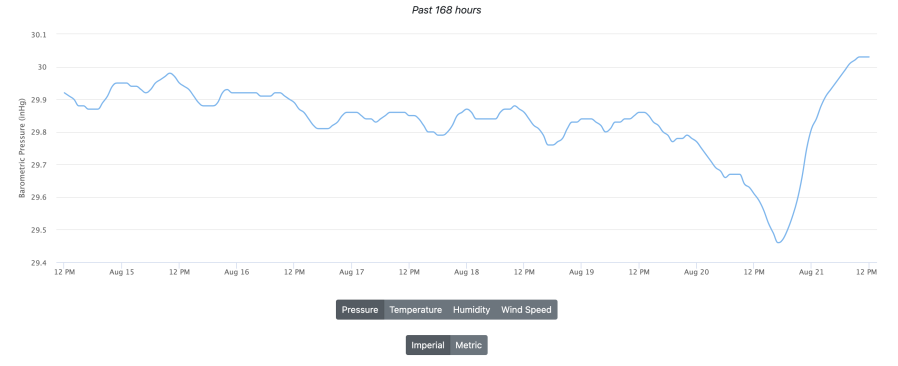Prepping for a historic weather event can be stressful, time-consuming and headache-inducing… literally.
If you experienced a headache while Tropical Storm Hilary made itself known in Southern California, you aren’t alone.
Google searches involving the terms “headache,” “Hilary” and other weather-related terms saw a spike over the weekend. Posts on social media also complained about the sudden onset of headache symptoms.
So what gives?
Aside from flooding roadways and knocking over trees, Hilary also wreaked havoc on some people’s bodies by way of lowering the barometric, or atmospheric, pressure.
Barometric pressure is, essentially, the measurement of the weight of the earth’s atmosphere.
Drops in atmospheric pressure are typically associated with storms, with tropical storms and hurricanes among the most noticeable; the lower the pressure, the more powerful the storm tends to be.
According to the Cleveland Clinic, research has shown that changes in barometric pressure can be associated with the onset of mild to even severe headaches.
Barometric pressure is the amount of pressure being applied against an area — in this instance, your body. When that pressure changes even slightly, your body, which is used to relatively consistent pressure levels, reacts.
“Because your nasal and sinus cavities are air channels, any change in that pressure, especially a fall in barometric pressure, affects those areas. This forces fluid into tissues and can cause a disruption in fluid balance,” the Cleveland Clinic writes. It’s the same mechanism that causes older people, or those who have suffered joint issues, to experience discomfort in the knees and other joints when a storm is approaching.
For some people, the change in barometric pressure can cause headaches, according to Dr. Emad Estemalik, a headache and facial pain specialist at the renowned medical center.
“When these pressure changes occur, most commonly during a storm, a headache can be triggered,” Estemalik said.
According to barometricpressure.app, a website which tracks atmospheric pressure across the globe, the Los Angeles area experienced a sizeable drop in atmospheric pressure when Hilary arrived.
Last Monday, barometric pressure in Los Angeles measured at 29.92 inHG, aka, inch-of-mercury — how barometric pressure is measured. That’s average for a normal day at sea level, according to the National Weather Service.
But on Sunday around 5 p.m., pressure plunged to as low as 29.46 inHG.
While that doesn’t sound like a lot, viewing the change in pressure on a graph reveals how much of a dramatic shift that really is. And even the slightest change in pressure can be felt pretty heavily by our bodies.

Symptoms of a barometric pressure headache include facial discomfort or pain around the sinuses, post-nasal drip and teary eyes, in addition to the typical migraine-like symptoms.
Luckily, there are plenty of things you can do to treat a barometric pressure headache, including taking over-the-counter medications like you would for any other migraine or tension headache.
Other steps that might ease your symptoms include wearing sunglasses and drinking water. Getting a healthy night’s sleep and managing your stress, often easier said than done, are good preventative measures.
There are also a handful of natural remedies that Estemalik recommends, which can be found here.





















